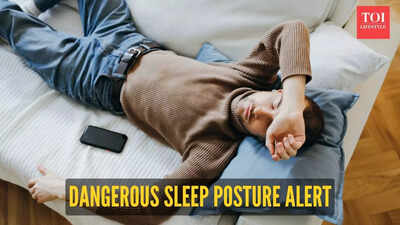Sleep is meant to restore and refresh the body, yet the way one lies down can silently do harm. For many adults, one particular position quietly increases risk, not just for aches, but for breathing and brain-oxygen levels. Here’s everything we need to know about the hidden danger, safer alternative, and how long and when to sleep for optimal brain and body health.
Which is the most dangerous sleep position?
Sleeping face-down (the prone position) might feel cosy, but research flags it as the least supportive posture. It can twist the neck, hyperextend the spine, and reduce lung capacity.More critically, for infants, prone sleeping is linked to lower cerebral oxygenation and a higher risk of sudden death.While adult data do not exactly mirror infant risk, the principle holds: compromised airway or compression around the chest/abdomen during prone sleep may reduce oxygen delivery to the brain over time. A 2024 study found significant differences in cardiac output and pulmonary arterial pressure between supine and prone positions.Hence the dramatic phrasing: sleeping in a posture that “starves” the brain of oxygen is not hyperbole in extreme contexts, impaired ventilation or airway collapse can lead to hypo-oxygenation of brain tissue.
Why the brain needs good oxygen during sleep
It’s not just about the body resting. While asleep the brain wipes out its metabolic “trash” via the glymphatic system, which works best when the body and circulation are optimal, as per a study published in the NIH.Poor position, airway obstruction or reduced lung ventilation can slow that clearance and reduce oxygen supply, both of which can impact cognition, memory consolidation and cerebral health.Thus a bad sleep posture doesn’t just affect back pain, it can subtly affect how the brain recovers overnight.

The safer posture: Side sleep or back sleep with care
Based on the evidence, two positions deserve strong consideration:
- Side-sleeping (lateral): This keeps the spine more neutral, reduces airway collapse, and helps promote better breathing.
- Back-sleeping (supine): In an ideal environment (good mattress support, minimal airway obstruction) this aligns the spine well. But for many people with snoring or sleep-apnoea, it may worsen airway collapse.
For most healthy adults without sleep-breathing disorders, side sleep offers the best mix of spinal alignment and ventilation. When choosing pillow height, mattress support and leg/knee placement matter – eg, a pillow between the knees for side-sleepers helps keep hips level.If sleep-apnoea or heavy snoring is present, side or semi-elevated back sleep may be beneficial.
Duration and timing: How much and when to sleep
Aim for 7 to 9 hours per night for most adults. Long-term patterns below 6 or above 9 have been linked to cognitive decline, metabolic issues and vascular risk.
- Try to sleep at night (ideally between 10 pm and 6–7 am) so the brain’s natural repair systems align with circadian rhythms.
- Avoid staying in one rigid position all night: gentle repositioning helps prevent local pressure, stiffness and micro-circulation issues. A 2025 study found that fewer position shifts were linked to better sleep quality and less apnoea severity.
- Allow a wind-down period 30-60 minutes before bed: dim lights, turn off screens, keep the room cool (around 16-19 °C if possible), this primes brain oxygenation and glymphatic clearance.

Why the danger is not just “back or neck pain”
It’s tempting to dismiss sleep posture as purely orthopedic (backs, necks). But the consequences go deeper:
- Stomach-sleepers may restrict chest expansion and compress the abdomen, reducing respiratory efficiency. Turned neck means vertebral blood flow and drainage may be altered.
- Side-sleep posture optimises the brain’s waste-clearance mechanism (via lateral channels) better than back or stomach.
- Chronic low-level hypoxia during sleep (due to airway obstruction or posture) can drive vascular changes, cognitive decline and brain-volume loss over decades (eg, in untreated sleep-apnoea).
Thus, the posture that prevents “brain starvation” isn’t about dramatic collapse, it’s about subtle but cumulatively harmful impairment over years.
Practical tips for adopting a healthier sleep position
If you currently sleep on your stomach, try placing a firm body-pillow on one side to discourage rolling onto your belly.
- Use a thin pillow (or no pillow) under your head if you switch to side or back sleep; avoid huge pillows that force neck flexion. For side sleep, pillow between knees helps.
- Choose a mattress that supports your natural curve, medium-firm usually beats very soft. Stomach sleepers especially will benefit from a firmer surface.
- If you wake with neck/shoulder pain, check your head-turning angle, pillow loft and mattress sag.
- For optimal timing: stick to a consistent bedtime, avoid heavy meals and caffeine 2–3 h before bed, and ensure good bedroom ventilation so that oxygen fresh-air supply is steady.
Disclaimer: This article is for general informational purposes only and does not substitute professional medical advice. Individuals with existing sleep disorders (such as sleep apnea), respiratory, cardiac or spinal conditions should consult a qualified healthcare provider for personalised guidance.

